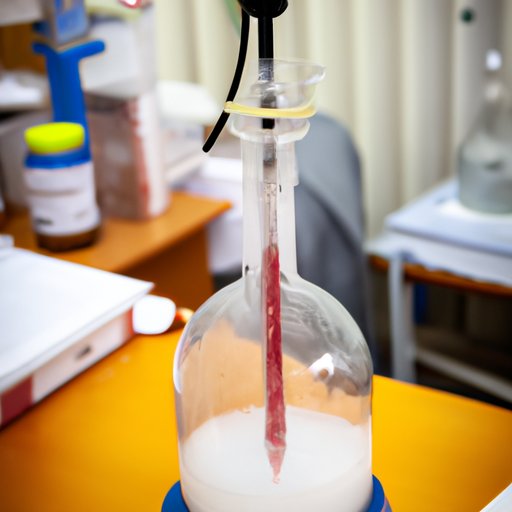
Introduction
Concentration measurement is an essential process in many fields, from chemistry to medicine to manufacturing. The concentration of a solution refers to the amount of solute that is present in a given amount of a solvent or solution. In other words, concentration measurement tells us how much of a substance is dissolved in a liquid or gas. It is crucial to accurately measure concentration as it affects the properties and behavior of solutions, and therefore it has a significant impact on science and daily life. This article aims to guide you on how to find the concentration of a solution through various methods, from the basic concepts of concentration measurement to advanced techniques.
Understanding Concentration Measurement Basics
In concentration measurement, we use units such as molarity, percentage weight by volume (% w/v), or parts per million (ppm) to describe the amount of solute present in a solution. The most common unit of measurement is molarity, which is the number of moles of solute present in one liter of solution. Percentage weight by volume measures the grams of solute present in 100 milliliters of solution, while parts per million means the number of parts of solute per million parts of solution. Furthermore, there are several ways to calculate the concentration, whether it is through molarity, percentage, or parts per million. The formula depends on the unit applied, and it is critical to choose the appropriate one given the nature of the solution.
Using Titration to Find the Concentration of a Solution
Titration is a common laboratory technique used to determine the concentration of an unknown solution by adding a known amount of titrant to it. The point at which the reaction between the titrant and the unknown solution is complete is called the endpoint. The amount of titrant used to reach the endpoint can be used to calculate the concentration of the unknown solution. The method is useful when a highly accurate concentration measurement is needed. Here are the basic steps to conduct titration:
- Choose a suitable indicator for the reaction.
- Add a known amount of titrant to a measured volume of the solution with unknown concentration.
- Observe the color change of the solution during the reaction.
- Stop adding titrant when the endpoint is reached, which is usually indicated by a change in color or pH.
- Measure the volume of titrant used to reach the endpoint.
- Use the volume of titrant, the known concentration of the titrant, and the balanced equation to calculate the concentration of the unknown solution.
Step-by-Step Guide to Finding the Concentration of a Solution
Here’s a step-by-step guide on how to find the concentration of a solution:
- Understand the nature of the solution, whether it is acidic or basic, and what type of solvent is used.
- Select the most suitable method for concentration measurement based on the solution and desired accuracy.
- Gather all necessary materials, including a balance, volumetric flask, pipette, burette, indicator, and solutions.
- Measure or weigh the solute and dissolve it in the solvent.
- Determine the volume of solvent or solution needed. Use a volumetric flask to make the solution more precise.
- Perform the chosen method for concentration measurement, whether it is titration, spectrophotometry, or other applicable approach.
- Calculate the concentration of the solution using the appropriate formula or equation.
The Importance of Accuracy in Concentration Measurement
The accuracy of concentration measurement is essential for various reasons. In scientific research and manufacturing processes, accurate concentration measurement ensures that solutions have the desired properties and behavior. In medical and forensic fields, it affects the accuracy of diagnoses and analyses. Furthermore, inaccurate concentrations might cause safety hazards, equipment damage, or financial losses. As such, it is essential to ensure maximum accuracy in concentration measurement.
Common Errors in Concentration Measurement and How to Avoid Them
Inaccurate concentration measurement can occur due to many reasons, including human errors, instrumental errors, and environmental errors. Some examples of human errors are parallax error, errors in measuring volumes or mass, and errors in reading instruments. Instrumental errors might arise from inaccurate calibration or malfunctioning of equipment, while environmental errors can stem from variations in temperature, pressure, and humidity. Despite the potential for errors, some ways to mitigate them include proper training and technique, equipment maintenance, and controlling environmental factors.
Different Methods of Concentration Measurement and How to Choose the Right One
Various methods are available for concentration measurement, including titration, spectrophotometry, chromatography, electroanalytical methods, and others. The choice of method depends on the type of solution, the desired accuracy, and the availability of equipment. Some methods may be time-consuming, while others require specialized training or expensive equipment. It is essential to weigh the pros and cons of each method before deciding on the most appropriate one.
Real-World Applications of Concentration Measurement and Why It Matters
Concentration measurement is an essential process in various industries, including pharmaceuticals, food and beverage, water treatment, and many others. In pharmaceuticals, accurate measurement ensures that the prescribed dosage of medication is achieved. In food and beverage, concentration measurement affects the taste, texture, and shelf life of the product. In water treatment, accurate measurement affects the safety of drinking water. The list is endless, but the common thread is that accurate concentration measurement ensures the desired quality, safety, and performance of the final product.
Conclusion
Concentration measurement is an essential process in various fields and applications. Accurate measurement ensures desired properties, behaviors, and safety, while inaccurate measurement may lead to hazards and financial losses. This article covered the basics of concentration measurement, various methods and their pros and cons, common errors and how to mitigate them, and real-world applications. With the information provided, you should be able to choose the appropriate method and maximize accuracy in concentration measurement.





